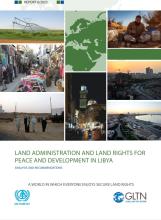Land Library Search
Through our robust search engine, you can search for any item of the over 73,000 highly curated resources in the Land Library.
If you would like to find an overview of what is possible, feel free to peruse the Search Guide.
/ library resources
Showing items 1 through 9 of 9912.This report is a contribution towards the improvement of land management and land administration in Libya.
To ensure a better and more sustainable future for all, the 2030 Agenda for Sustainable Development (“the 2030 Agenda”) has identified 17 Sustainable Development Goals (SDGs) to be achieved by 2030.
The Global Land Indicators Initiative (GLII) platform was established in 2012 through the joint effort of United Nations Human Settlements Programme (UN-Habitat), the World Bank and Millennium Challenge Corporation with the aim of making global-scale monitoring of land governance a reality by 202
The aim of this research was to study the effect of the stand composition on the density of pine and spruce wood growing on former arable lands. Sample areas are located in mixed mature pine- and spruce-prevailing stands in Leningrad region, Russia.
The objective of this study is to assess the qualitative and quantitative characteristics of pine (Pinus sylvestris) and spruce (Picea abies) stands growing on lands that were previously in agricultural use in the Leningrad region.
The scientific and technical crop production market (STCPM) is a system of organizational, economic and legal relations between the participants of the selection and seed-growing process. Selection achievements are the main commodity in it.
The article presents an analysis of the existing situation of forests of the Republic of Lithuania. The situation is analysed in ten counties of the country. In the Republic of Lithuania, forests occupied 2,178,958.04 ha, country’s forest coverage – 33.38% in 2017.
The territorial planning and the management of urban surfaces force the decrease of green spaces in urban landscapes.
Significant areas of agricultural lands of Primorsky Territory (664.2 thousand hectares) are subjected to various erosion processes, therefore they need to be conservated by afforestation.



